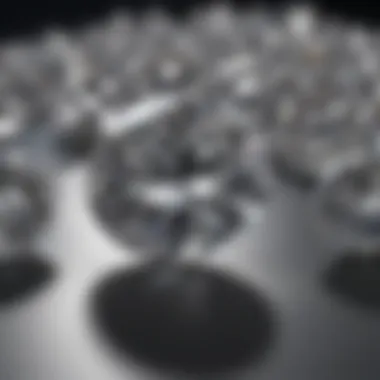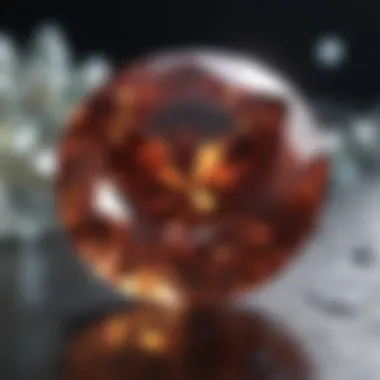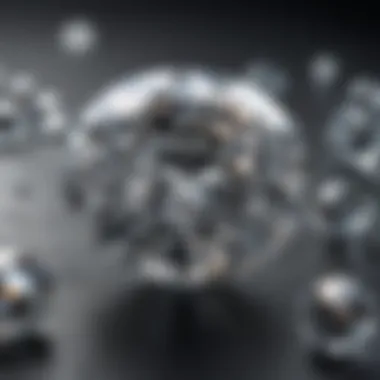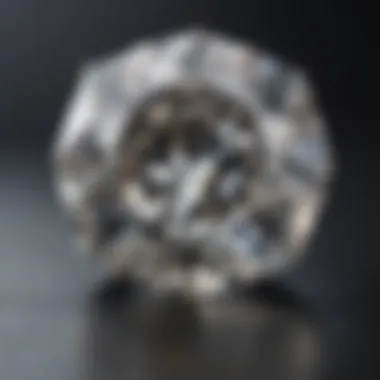Moissanite vs Diamond: Pricing Insights and Trends


Intro
Understanding gemstones is vital for anyone interested in their beauty and value. This article aims to dissect the complexities surrounding moissanite and diamonds, focusing specifically on their pricing. Both stones appeal to consumers, yet they represent different values and market dynamics. Hence, a comprehensive understanding of price differences can guide buyers in making informed choices.
Overview of Gemstones and Minerals
History of Gemstone and Mineral Use
Gemstones have fascinated humans for millennia. Ancient civilizations, such as the Egyptians and Mesopotamians, utilized them for various purposes, including adornment, trade, and religious rituals. Historically, diamonds were reserved for royalty, while other gemstones played significant roles across cultures—ruby for protection, sapphire for wisdom, and emerald for fertility.
Significance in Culture and Society
Gemstones symbolize different emotions and attributes. They often serve as tokens of love, friendship, or power. Diamonds, in particular, have come to signify everlasting commitment in engagement rings. In contrast, moissanite, discovered in a meteorite, often represents an alternative choice embracing modernity and ecological consciousness.
Factors Influencing Pricing
With the backdrop of historical relevance, one must now consider the factors that influence the pricing dynamics of moissanite and diamonds.
Natural vs. Synthetic Origins
The origin of the stone plays a significant role in its economic worth. Diamonds, primarily sourced from nature, embody rarity. The mining process is costly, influencing the retail price. Conversely, moissanite is lab-created, which significantly lowers production costs, thus making it more affordable.
Market Demand and Trends
Market demand directly impacts pricing. In recent years, the shift towards ethical consumption has increased moissanite's popularity. More individuals seek alternatives to traditional diamonds due to concerns surrounding conflict stones and environmental sustainability. The growing appeal of moissanite has caused fluctuations in its market pricing.
Quality and Characteristics
Although diamonds are renowned for their brilliance and durability, moissanite possesses remarkably similar attributes. The dispersion of moissanite is higher than that of diamonds, yielding a unique sparkle. This characteristic can influence consumer perception and, consequently, pricing.
Consumer Perception and Choices
A significant aspect of evaluating the price difference between these two gemstones is how consumers perceive them.
Emotional Value
Diamonds, often associated with tradition, carry a strong emotional attachment for buyers. Many consumers consider diamonds more prestigious, impacting their willingness to pay higher prices. Moissanite is frequently viewed as a smart financial choice without compromising appearance.
Education and Awareness
Despite growing popularity, many consumers are unaware of moissanite’s qualities. Education plays a role in bridging this knowledge gap. Awareness campaigns and discussions in communities, such as those on reddit.com, can shed light on the benefits and characteristics of moissanite versus diamonds.
"Understanding the properties of gemstones can empower consumers to make informed choices."
Closure
As the conversation surrounding gemstones continues to evolve, so do their prices. By evaluating the historical significance, formation processes, and consumer perceptions, individuals can better understand the intricate landscape of gemstone pricing. Moissanite offers an increasingly relevant alternative to diamond, appealing to consumers who prioritize ethical considerations and cost-effectiveness. Understanding these factors will serve as a vital tool for potential buyers, providing clarity in an often confusing market.
Prelims to Moissanite and Diamonds
Understanding the differences between moissanite and diamonds is crucial for anyone interested in gemstones, whether for personal use or investment. The relevance of this topic extends into various areas, such as pricing, aesthetic appeal, and ethical considerations. Many consumers are faced with the task of selecting a gemstone that fits their budget while also embodying desired qualities like brilliance and durability. By recognizing how each stone is defined and characterized, buyers can make informed decisions that reflect their values and preferences.
Definition of Moissanite


Moissanite is a gemstone that was first discovered in a meteorite by the French chemist Henri Moissan in 1893. Its chemical composition is silicon carbide, which leads to its remarkable optical properties, including high refractive index and brilliance. Synthetic moissanite is now produced to meet consumer demands, as natural occurrences of this stone are extremely rare. It is often marketed as a budget-friendly alternative to diamonds, capturing a significant share of the gemstone market. With its fire and sparkle, moissanite appeals not only to cost-conscious buyers but also to those seeking a modern and ethical choice in jewelry.
Definition of Diamonds
Diamonds are formed deep within the Earth under extreme conditions of pressure and temperature. Their structure is composed of carbon atoms arranged in a crystal lattice, which grants them exceptional hardness and brilliance. Diamonds are typically graded based on the Four Cs: cut, color, clarity, and carat weight. The rarity of diamonds, especially larger and high-quality specimens, contributes significantly to their high market value. While they symbolize luxury and status, there has been a shift in consumer perspective, with many buyers now considering alternative gemstones alongside traditional diamonds. The exploration of these definitions sets the stage for a deeper analysis of pricing dynamics in the gemstone market.
The Gemstone Market: Overview
The gemstone market is a complex and dynamic environment where various factors influence the pricing and availability of stones like moissanite and diamonds. Understanding this market is crucial for both consumers and investors because it shapes investment opportunities and affects personal jewelry choices. Exploring the intricate details of the gemstone market allows enthusiasts to appreciate the nuances between moissanite and diamonds, particularly in pricing strategies and historical trends.
The significance of this section lies in its exploration of how historical context and market demand shape the pricing of these gemstones. The pricing of diamonds has been heavily influenced by marketing and consumer perception, whereas moissanite has emerged as a competitive alternative due to its affordability. In addition, examining market demand trends uncovers insights into consumer behavior and preferences, which can help predict future market shifts.
Historical Context
The historical context of gemstones is fundamental to understanding their current market value. Diamonds, historically associated with wealth and luxury, have undergone significant transformations over the centuries. Initially, diamonds were sourced from alluvial deposits, but as mining developed, the supply chains expanded globally. The discovery of large deposits, particularly in South Africa during the late 19th century, drastically changed the landscape of diamond pricing.
In contrast, moissanite was first discovered in 1893 by Henri Moissan in a meteorite sample. Its commercial availability emerged much later, primarily as a lab-created alternative to diamonds. This positioning has allowed moissanite to present itself as an ethical and affordable choice, albeit within a market that is predominantly centered on diamonds. Understanding these historical narratives offers consumers a critical lens through which to evaluate the investment prospects of each gemstone.
Market Demand Trends
The current market trends provide valuable insights into consumer preferences and purchasing behaviors regarding diamonds and moissanite. Recent years have seen a shift in consumer awareness concerning ethical sourcing and the environmental impact of gemstone mining. This shift has contributed to the increased popularity of moissanite, which is marketed as a sustainable choice for socially-conscientious buyers.
Factors influencing market demand include:
- Economic conditions: Economic downturns can affect luxury spending, leading to changes in diamond sales and an increase in demand for more affordable alternatives like moissanite.
- Cultural influences: Jewelry styles and preferences fluctuate with social trends. Millennials and Generation Z have shown a preference for unique engagement rings, often opting for alternatives that evoke individuality rather than tradition.
- Promotional strategies: Traditional marketing strategies for diamonds have relied on campaigns emphasizing luxury and exclusivity. In contrast, moissanite leverages its sustainability narrative, appealing to a growing demographic focused on ethical consumption.
Understanding these demand trends is essential for consumers as it informs not only pricing but also their choices in selecting gemstones for investment or personal adornment.
Price Analysis: Moissanite vs Diamond
The section on price analysis is crucial for understanding the dynamics between moissanite and diamonds. Pricing reflects various factors, including quality, market trends, and consumer preferences. By analyzing these elements, buyers can make informed decisions regarding their gemstone purchases.
Base Price Comparison
When considering the base prices of moissanite and diamonds, several key differences emerge. Moissanite costs, on average, about 10% to 15% of the price of diamond equivalents. For instance, a one-carat diamond may cost between $4,000 to $6,000, while a comparable moissanite can be sourced for approximately $400 to $600. This stark contrast is one of the most immediate considerations for buyers.
Moissanite’s affordability makes it an attractive option for consumers who desire the elegance of a diamond without the hefty price tag. Furthermore, the lower price point allows for larger stone purchases, which can be compelling for those seeking significant visual impact in jewelry.
Factors Influencing Pricing
Understanding the factors that influence pricing for both moissanite and diamonds is essential. The primary elements include the quality of material, gemstone sourcing, and brand influence.
Quality of Material
Quality plays a critical role in pricing. Diamonds are graded based on the Four Cs: carat weight, cut, color, and clarity. The more superior a diamond ranks on these criteria, the higher its price. Moissanite also boasts high clarity and brilliance, yet it is not graded the same way as diamonds. While it can rival diamonds in appearance, it lacks formal certification processes like those of diamonds, which can lead to misunderstandings regarding value.
In terms of material quality, diamonds often exude a perceived luxury that moissanite does not yet fully attain in some markets. Understanding the grading systems is vital for potential buyers to appreciate their options fully.
Gemstone Sourcing
Sourcing greatly affects gemstone pricing. Diamonds predominantly originate from mines in Australia, Russia, and Africa. The mining process is labor-intensive and costly, resulting in a heightened price point. In contrast, moissanite is laboratory-created, which means it can be produced more efficiently and cost-effectively.
The eco-friendliness of laboratory sourcing is increasingly appealing to consumers concerned about the environmental impact of diamond mining. This appeals to a specific segment of buyers who prioritize sustainability and responsible purchasing decisions over traditional luxury norms.


Brand Influence
Branding significantly affects pricing structures within the gemstone market. Established diamond brands can charge premium prices based on their reputation and perceived value. Consumers may often be willing to pay more for well-known names, associating them with higher quality and status. Moissanite brands, on the other hand, are often newer to the market and may not yet possess the same level of recognition or prestige. However, this opens a dialogue about the value of quality over brand name.
Ultimately, brand can reinforce consumer perceptions and trust, but it should not overshadow the importance of gemstone quality and sustainability.
Quality Factors Affecting Pricing
Understanding the quality factors affecting pricing is essential in navigating the nuances of gemstone markets. Both moissanite and diamonds exhibit their own unique attributes, which can significantly impact their costs. The four primary factors that play a crucial role in this determination are cut, color, clarity, and carat weight. Each of these elements contributes to the perceived value and overall appeal of the stones, making them indispensable in a comprehensive analysis of pricing.
Cut, Color, and Clarity
The cut of a gemstone plays a vital role in its sparkle and overall aesthetic. For diamonds, the cut refers to how well the stone has been crafted, which directly influences its brilliance. A high-quality cut allows light to enter the diamond and reflect beautifully, maximizing its fire and scintillation. Moissanites, although often brighter than diamonds due to their higher refractive index, also require skilled cutting to exhibit their full potential.
Color is another determinant in the value of gems. Diamonds range from colorless to shades of yellow or brown. A more colorless diamond typically commands a higher price. In contrast, moissanites boast a more consistent color quality, often appearing completely colorless.
Clarity denotes the presence of internal or external flaws known as inclusions and blemishes. A stone with fewer imperfections will generally have a higher valuation. Diamonds categorized as "flawless" are exceedingly rare and, thus, proportionately expensive. Moissanites generally show better clarity; they are usually flawless or have insignificant inclusions visible only under magnification.
Carat Weight and Its Impact
Carat weight directly influences pricing, acting as a straightforward gauge of a gemstone's size. A higher carat weight often equates to a higher price, especially for diamonds. However, it's important to note that this can create a disparity in cost when comparing moissanite and diamonds.
Moissanites are often available in larger sizes at a fraction of the cost compared to diamonds. This variance occurs due to their abundance and the different perceptions surrounding their value. The perception of carat weight is also tied to the stone's physical proportions and overall appearance.
When evaluating both diamonds and moissanites, buyers must be informed of these quality factors. They are critical to making an informed decision in the comparison of pricing. The quality of the cut, the degree of clarity, the color grading, and the carat weight all intertwine to shape the pricing landscape in which these gemstones compete.
Consumer Perception of Value
Consumer perception of value plays a critical role in the jewelry market, especially in the comparison between moissanite and diamonds. Understanding how consumers evaluate these gemstones helps in comprehending market dynamics and purchasing decisions.
The perception of value is shaped by multiple factors including quality, price, and the emotional connection consumers have with the stones. For many buyers, the choice between a moissanite and a diamond extends beyond material attributes; it encompasses deeper emotional and personal significance. Educated consumers often assess both the aesthetics and the ethical implications of their purchases.
Understanding Value Propositions
The value proposition is a central theme when analyzing consumer choice between moissanite and diamonds. A value proposition clearly outlines the benefits and advantages that a product offers to potential buyers. For diamonds, the established reputation for rarity and luxury drives up perceived value, despite a higher price point. Consumers often associate diamonds with significant life events such as engagements or anniversaries, reinforcing their desirability.
On the other hand, moissanite presents a compelling alternative with a different value proposition. It provides similar visual appeal and brilliance at a significantly lower price. Furthermore, its reputation for being a more ethical choice appeals to modern consumers who are increasingly conscience about environmental impact. The examined factors include:
- Price Point: Moissanite generally costs much less than diamonds, making it accessible to a broader audience.
- Brilliance: Moissanite has a higher refractive index, which means it displays more sparkle than diamonds.
- Sustainability: Moissanite is lab-created, thus avoiding the ethical concerns rampant in diamond mining.
Emotional and Sentimental Value
Emotional and sentimental value contribute profoundly to consumer decisions regarding gemstones. Diamonds have long been marketed as the ultimate symbol of love and commitment. This historic narrative elevates them in the eyes of many consumers. A diamond engagement ring often carries weight not only in its physical form but also in what it signifies.
Conversely, moissanite can evoke strong emotions as well. For budget-conscious buyers or those prioritizing sustainability, choosing moissanite may blend practicality with personal values. Many consider the choice of moissanite as a statement of individuality and modernity, reflecting their beliefs about ethical sourcing.
In summary, consumer perception of value in the moissanite versus diamond debate is multifaceted. It combines financial considerations with sentiments, ethics, and personal narratives. By carefully evaluating these aspects, buyers can make informed choices that align with both their preferences and values.
"The greatest value lies in choosing what resonates with one’s beliefs and emotions, not just the price tag."
Understanding these dimensions provides deeper insights into the consumer landscape within the gemstone industry.
Sustainability and Ethical Considerations


Sustainability and ethical considerations hold significant importance in the discussion of gemstones, particularly when comparing moissanite and diamonds. These factors not only influence consumer choices but also reflect broader societal values regarding environmental responsibility and ethical sourcing. By examining how each type of gemstone impacts the planet and communities involved in their production, one can better understand the motivations behind choosing one over the other.
Environmental Impact of Diamond Mining
Diamond mining has a notable environmental footprint. Traditional mining practices can lead to habitat destruction, soil erosion, and significant water usage. It also generally involves a process that extracts gemstones from deep underground, which can disturb large areas of land. The use of heavy machinery further contributes to carbon emissions, heightening the ecological impact. Moreover, some diamond mines operate in sensitive ecosystems, often putting wildlife at risk.
The aftermath of such mining operations is also concerning. Restoration efforts may be insufficient, resulting in long-term damage to local environments. Furthermore, the socioeconomic implications of diamond mining can affect communities. Workers may face unsafe conditions, and local economies can become overly reliant on unstable mining operations.
Moissanite as a Sustainable Alternative
In contrast, moissanite presents itself as a more sustainable option. Most moissanites available today are lab-created, meaning they are produced in controlled environments rather than mined from the earth. This method significantly reduces the environmental harm associated with traditional mining. Lab-grown stones require fewer natural resources and less energy, making the production process more environmentally friendly.
There is also no risk of conflict associated with lab-created moissanite, which often plagues diamond sourcing. The term "blood diamonds" refers to gems mined in war zones and sold to finance armed conflict, which has raised ethical concerns about diamond purchasing. Consumers who prioritize ethical sourcing may find moissanite to be a preferable choice, as its production avoids many of the moral dilemmas associated with diamonds.
"Choosing moissanite can reflect a commitment to sustainability and ethical considerations in gemstone purchasing."
Additionally, moissanites are often less expensive than diamonds, making them an attractive option for those who wish to invest in a beautiful gemstone without the associated environmental and ethical costs of traditional diamonds. More consumers are now prioritizing sustainability in their purchasing decisions. Thus, moissanite, with its minimal ecological impact and ethical sourcing, stands out as an appealing alternative.
Jewelry Market Preferences
Understanding the preferences within the jewelry market is essential for discerning consumers and industry stakeholders alike. This aspect reveals how different gemstones, especially moissanite and diamonds, are positioned in consumer minds. Factors like design trends, marketing efforts, and cultural significance shape these preferences. Knowledge in this area aids buyers in making informed decisions and assists designers in aligning their offerings with customer desires.
Popular Jewelry Designs
Jewelry design trends evolve over time, reflecting shifts in consumer preferences. Popular designs that incorporate moissanite and diamonds often highlight the unique characteristics of each stone. Here are some notable trends:
- Solitaire Rings: Single-stone rings remain timeless. While diamonds have traditionally dominated this category, moissanite is gaining traction due to its affordability and brilliance.
- Halo Settings: This design features smaller stones surrounding a center gemstone, enhancing its appearance. Both moissanite and diamonds shine in halo settings, attracting attention from various demographics.
- Vintage Styles: Art Deco and vintage-inspired designs appeal to those seeking uniqueness. Moissanite's growing acceptance promotes its usage in these styles, attracting budget-conscious buyers who still desire elegance.
- Custom Jewelry: Personalized pieces are increasingly sought after. Moissanite offers versatility in customization while maintaining a lower price point than diamonds.
Jewelry trends influence purchasing decisions. As designs reflect preferences, consumers consider factors such as how well a piece fits their individual style and values.
Customer Demographics and Trends
The consumer demographic for moissanite and diamonds is diverse. It encompasses various age groups, income levels, and preferences. The following insights illustrate this landscape:
- Younger Consumers: Millennials and Gen Z consumers often seek ethical options and sustainability. Moissanite, with its minimal environmental impact, appeals strongly to this demographic, and many opt for it over diamonds to minimize their carbon footprint.
- Affluent Buyers: Those with higher income levels may still gravitate toward diamonds for their prestige and traditional value. However, an increasing number of affluent consumers recognize the beauty in moissanite, appreciating its affordability coupled with quality.
- Occasional Buyers vs. Frequent Buyers: Occasional buyers typically prioritize price and resale value, thus gravitating toward diamonds. Frequent buyers, such as jewelry enthusiasts, may explore moissanite for its equal aesthetic value without the hefty price.
Trends such as online shopping have also emerged, creating a broader market. Consumers have access to various types of stones and jewelry styles, making it easy to choose based on preferences and values. In contrast to traditional retail, the online landscape offers price comparisons and detailed product descriptions, empowering informed purchasing decisions.
"Understanding consumer preferences represents a vital part of navigating the jewelry market. It provides insights into trends, influences, and future developments."
In summary, jewelry market preferences play a pivotal role in redefining how moissanite and diamonds are perceived and valued. Recognizing design trends and customer demographics enables stakeholders to adapt and succeed in this competitive space.
End: Making an Informed Choice
In the context of the jewelry market, understanding the pricing dynamics of moissanite and diamonds is crucial for making informed decisions as a consumer. This final section synthesizes the key points discussed throughout the article and highlights the considerations buyers should keep in mind.
Final Thoughts on Pricing
When we evaluate the price differences between moissanite and diamonds, several elements come into play. Moissanite tends to be less expensive than diamonds, primarily due to factors such as availability and production methods. While diamonds are mined from finite resources, moissanite can be created in laboratories, leading to a more stable price point.
Moreover, the perception of value plays a significant role in pricing. Diamonds have held a longstanding reputation as symbols of luxury and status, influencing their market demand. Despite moissanite’s impressive physical properties, such as brilliance and hardness, it may not yet enjoy the same level of esteem among consumers. Therefore, buyers must weigh not only the financial cost but also the emotional and cultural significance attached to their choice.
Considerations for Buyers
As potential buyers consider their options, several important factors should guide their decision-making process:
- Budget: Understand your financial limits and how each stone fits within your budget. Moissanite can offer exceptional value for those looking for beauty without breaking the bank.
- Purpose: Consider the intended use for the gemstone. If the stone is for an engagement ring or significant piece of jewelry, the emotional value may outweigh the monetary price.
- Resale Value: Investigate how the resale market values moissanite compared to diamonds. This knowledge may influence long-term financial considerations.
- Ethical Choices: For some consumers, the ethical implications of gemstone sourcing are critical. Moissanite, produced in laboratories, might appeal to those focused on sustainability and ethical practices.
"Understanding the nuances of pricing can empower consumers to make choices that align with their values and financial goals."
Ultimately, the decision between moissanite and diamonds should rest on individual preferences, financial considerations, and personal values. By weighing these factors, consumers can make informed choices that resonate with their needs and aspirations.







